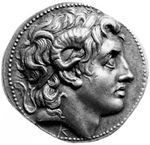Template:Pictorial-Islam-options: Difference between revisions
| [checked revision] | [checked revision] |
(Replaced content with "<noinclude>Also see: Template:Pictorial-Islam</noinclude><!-- HELP NOTES: Each option tag handles one random story --><choose> <option weight="1">{{Pictorial-Islam|1=...") Tag: Replaced |
No edit summary |
||
| Line 5: | Line 5: | ||
<option weight="1">{{Pictorial-Islam|1=Dhul-Qarnayn and the Alexander Romance|2=[[File:Alexander the Great.jpg|150px|link=Dhul-Qarnayn and the Alexander Romance]]|3=RThe story of Dhul-Qarnayn (in Arabic ذو القرنين, literally "The Two-Horned One", also transliterated as Zul-Qarnain or Zulqarnain) is found in the 18th Surah of the Qur'an, al-Kahf (the Cave). While he is never mentioned explicitly by name, the story is clearly based upon a legendary account of Alexander the Great. For centuries, most Muslim historians and Qur'anic commentators endorsed the identity of Dhul-Qarnayn as Alexander, though some also proposed alternatives. In recent years, this identification of Dhul-Qarnayn has become particularly problematic and controversial for Muslim scholars, as historians have gradually discovered that the historical Alexander was a Greek pagan who fashioned himself as a god. ([[Dhul-Qarnayn and the Alexander Romance|''read more'']])}}</option> | <option weight="1">{{Pictorial-Islam|1=Dhul-Qarnayn and the Alexander Romance|2=[[File:Alexander the Great.jpg|150px|link=Dhul-Qarnayn and the Alexander Romance]]|3=RThe story of Dhul-Qarnayn (in Arabic ذو القرنين, literally "The Two-Horned One", also transliterated as Zul-Qarnain or Zulqarnain) is found in the 18th Surah of the Qur'an, al-Kahf (the Cave). While he is never mentioned explicitly by name, the story is clearly based upon a legendary account of Alexander the Great. For centuries, most Muslim historians and Qur'anic commentators endorsed the identity of Dhul-Qarnayn as Alexander, though some also proposed alternatives. In recent years, this identification of Dhul-Qarnayn has become particularly problematic and controversial for Muslim scholars, as historians have gradually discovered that the historical Alexander was a Greek pagan who fashioned himself as a god. ([[Dhul-Qarnayn and the Alexander Romance|''read more'']])}}</option> | ||
<option weight="1">{{Pictorial-Islam|1= | <option weight="1">{{Pictorial-Islam|1=Seven Sleepers of Ephesus in the Quran|2=[[File:Seven_sleepers.jpg|170px|link=Seven Sleepers of Ephesus in the Quran]]|3=The Qur'anic story of the "Companions of the Cave" has traditionally been explained by the Islamic narrative as proof of Allah's divine power whereby he miraculously caused 7 youths to fall asleep and awaken after more than 300 years. Yet comparison with the literary milieu of the Qur'an, 7th century Chrisian culture in the Middle East, reveals parallels to the 7 Sleepers of Ephesus, a Christian legend dating from the 5th century which tells the story of Christian youths being persecuted by the pagan Roman Emperor Decius in the 3rd century. ([[Seven Sleepers of Ephesus in the Quran|''read more'']])}}</option> | ||
</choose><!-- HELP NOTES: <option>{{Pictorial-Islam|1=TITLE OF STORY|2=IMAGE LINK (SEE ABOVE FOR EXAMPLE)|3=TEXT OF STORY - SHOULD INCLUDE READ MORE LINK}}</option> --><noinclude>[[Category:Templates]][[Category:Random Templates]]</noinclude> | </choose><!-- HELP NOTES: <option>{{Pictorial-Islam|1=TITLE OF STORY|2=IMAGE LINK (SEE ABOVE FOR EXAMPLE)|3=TEXT OF STORY - SHOULD INCLUDE READ MORE LINK}}</option> --><noinclude>[[Category:Templates]][[Category:Random Templates]]</noinclude> | ||
Revision as of 07:44, 17 December 2020
Also see: Template:Pictorial-Islam
|
